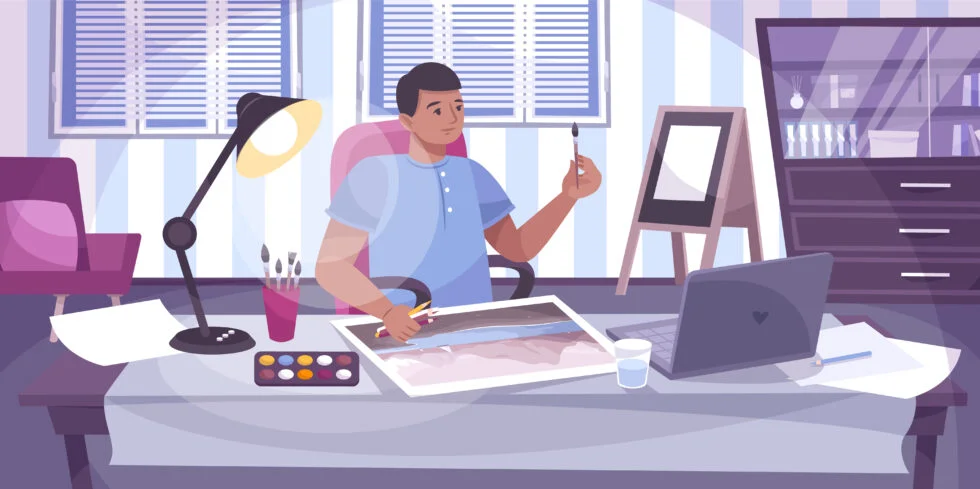Art has always been a world of ever-changing definitions. The medium of art has changed from caves to canvases to metaverse galleries. Paint brushes changed from bones to VR handsets. No wonder Picasso once said that “In art, there is room for all possibilities.”
Art has always been an immersive experience for both the creators and the audience. Where renaissance era paintings bought divinities to life with amazing frescos on domes, modern day art focuses more on social realism. With the emergence of Web3, art has taken on a new form.
Art has always been an immersive experience for both the creators and the audience. Where renaissance era paintings bought divinities to life with amazing frescos on domes, modern day art focuses more on social realism. With the emergence of Web3, art has taken on a new form.
THE ADVENT OF WEB3 IN FINE ARTS

The history of humanity has always included art. Although all kinds of art are significant from a cultural perspective, the appeal of fine art is unrivalled. That is most likely why there are more fine art galleries and old painting museums than pottery shows.
However, the underlying fact that the creators of these masterpieces have always struggled to preserve their work via rough deals has now established itself as a waning problem. The profit has always been eaten away by a third party the entire time. With the introduction of new technology, the situation has substantially improved.
Web3’s decentralized environment and blockchain-based technologies like NFTs have been the ultimate contemporary answers to these issues that can benefit artists’ conditions. Artists can regain control over their works and the ways in which they are used by developing works in the form of NFTs. Additionally, purchasing NFT art is a long-term investment for customers. Years after purchasing it, they may still sell the NFT paintings they bought for a profit.
So basically, the advent of Web3 in the world of fine arts has created a productive bridge between artists and collectors.
PROBLEMS FACED BY ARTISTS

As a universal language, the arts sector plays an important role in the social and economic growth of any country. Sadly, there are several difficulties that the art world is now facing, for example:
#1 Disorganized Pricing: There is no set formula for how much art should cost. Art galleries and similar organizations keep their pricing structure extremely a secret. As a result, problems like unpredictable pricing for consumers and unfair profit sharing with artists arise.
#2 Interference of Third Parties: In order to sell their works of art, artists must rely on other parties like art galleries and auction houses. The resulting profit is split among the participants. Artists typically receive significantly less money than the real revenue generated by their works of art.
#3 Plagiarism: Another urgent problem affecting the creative sector is copyright. Duplication of works of art is simple and pervasive since there is no failsafe method to keep information about a specific piece of art, including its original owner and price. Artists suffer greatly from this as their original creations lose their novelty and uniqueness.

WEB3 – AN ARTISTIC TRIUMPH

HOW DOES WEB3 PLAY A ROLE IN FINE ARTS?

Web3’s distinctive characteristics, such as decentralization, immutability, and the usage of a transparent distributed ledger, are causing its popularity and industrial applicability to soar. In essence, web3 is one of the most ground-breaking inventions of the twenty-first century because of these characteristics. Web3, the safest and most dependable technology, provides the creative business with a wide range of potential applications.
#1 Art Galleries
Technology and art galleries used to be poles apart. One went so far as to slander the other. However, with the introduction of Virtual Reality and its limitless ramifications, both sides have combined into a lovely whole – starting with art museums.
No matter how much the world progresses, there will always be a need for art galleries. Online art galleries are one of the cutting-edge technologies that web3 has been able to propel. With the support of these blockchain-based art galleries, all operations including purchasing and selling artwork have therefore transitioned to the digital realm.
#2 Creating New Worlds
With the emergence of Web3, there has been an increase in different virtual realms. Apart from developers, the other important cog that goes into the creation of these environments are digital artists.
Artists have the ability to transform a blank canvas into a new world. With the help of VR art, they cannot only create worlds but also exist inside their masterpieces.
This gives rise to so many platforms; gaming, commercial, recreational – the possibilities are truly endless.
#3 Revolutionizing Art Education
The field of education is also embracing Web3. Since VR offers students a learning experience unlike any other, top art and design institutions like the Royal College of Art in London are attempting to overhaul the educational model using it!
These prestigious art school institutions see virtual reality as a fantastic chance to reduce their carbon impact and save money. In addition to huge sums of money, thousands of pounds of raw resources like paper, paint, and other stationery would be saved. The reduction in running expenses suggests that these institutions may be opened for more people, which would benefit both the environment and the people.

NFTs have been one of the most impactful aspects of Web3 since they have completely transformed traditional art to modern art. Apart from providing exciting innovation for art galleries and museums, NFTs have also proven to be profitable for artists and collectors.
Due to NFTs, artists can actually strengthen their position in the world of art due to the tokens of authenticity. This will give them the rights to control, present or resell their work. In addition, NFTs are tied to smart contracts. This allows artists to receive every cut of the sale.
As for collectors, Web3 directly connects them with their favourite artists due to which they can build long lasting relationships. Moreover, buying your favourite art gets so much easier. Collectors can easily buy or trade digital assets with a few taps on their devices.
Logging Out
Numerous developers are striving to develop Web3, which is the third generation of the internet. Its purpose is to restore personal privacy, anonymity, and openness in web usage, and it achieves this by leveraging blockchain technology as an open ledger for all digital information on the web. As a result, the internet is decentralised.
The art industry is one of the fields that can greatly benefit from this technology. For example, artists can create a digital identity for their artwork and keep track of its sale lineage throughout their life. Furthermore, larger investors can purchase art using cryptocurrency, while smaller investors can also participate using digital currency. If you are interested in investing in art or selling it, blockchain is definitely worth considering!




